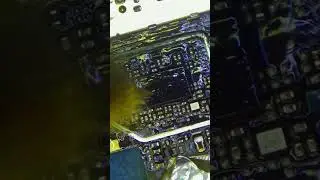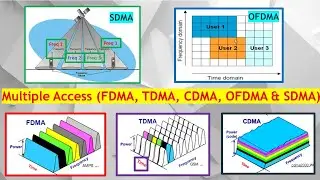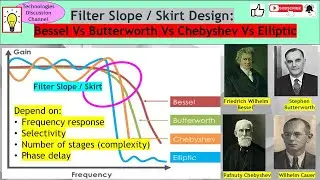Bluetooth Part 1. Classic Bluetooth Vs Bluetooth Low Energy (BLE). What is Piconet & Scatternet.
Bluetooth playlist. Watch these video to understand more on Bluetooth Connectivity.
• Bluetooth Part 1. Bluetooth System Ar...
Wireless Connectivity playlist. Watch these video to understand more on Wireless Connectivity
• Video
Classic Bluetooth
Bluetooth is a wireless communication technology that allows devices to exchange data over short distances. It operates in the 2.4GHz ISM (Industrial, Scientific and Medical) radio band and uses low-power and short-range radio waves to connect various devices such as smartphones, laptops, speakers, headphones, printers, and many other electronics devices.
Bluetooth Low Energy (BLE)
BLE is a key feature introduced in Bluetooth 4.0 and is optimized for low-energy applications, enabling devices to work for months or years on a small battery. BLE is commonly used in applications such as fitness trackers, medical devices, smart home products, and other Internet of Things (IoT) devices.
Bluetooth devices communicate with each other by forming a network called a piconet. In a piconet, one device acts as the master while the others are slaves.
PICONET
2 or more Bluetooth units sharing a channel form a piconet.
Connected units can be master or slave.
Master is the device that initiates the formation of a piconet.
Master can connect to max. 7 slaves per piconet.
Each piconet is defined by a different hopping channel to which users synchronize to.
Hopping pattern is determined by the master.
A scatternet consists of overlapping piconets. You can have a Bluetooth device that participates in several piconets simultaneously, but can only be active in one at a time. A single device can be a slave in several piconets, but can only act as a master in one piconet.
Bluetooth has evolved through several versions
Bluetooth 1.0/1.1: The initial versions, which were relatively slow and had compatibility issues.
Bluetooth 2.0 + EDR (Enhanced Data Rate): Improved speed (up to 3 Mbps) and power efficiency.
Bluetooth 3.0 + HS (High Speed): Added support for faster data transfer using Wi-Fi for large files.
Bluetooth 4.0: Introduced Bluetooth Low Energy (BLE), allowing even lower power consumption for devices like fitness trackers.
Bluetooth 4.1 & 4.2: Introduced improvements in coexistence with LTE networks, higher speeds, and enhanced security features.
Bluetooth 5.0 & 5.1: Provided longer range (up to 240 meters in ideal conditions), faster speeds (up to 2 Mbps), and greater capacity for connections. Bluetooth 5.1 added directional finding features.
Bluetooth 5.2: Introduced features like LE Audio, which provides better sound quality for hearing aids and wireless audio devices, as well as improved efficiency and multi-streaming support.
Bluetooth is used in a wide variety of applications:
Audio: Wireless headphones, speakers, and car audio systems use Bluetooth for audio streaming.
File Transfer: Bluetooth is used for transferring files between devices, such as sending photos or documents.
Wearables: Fitness trackers, smartwatches, and heart rate monitors often use Bluetooth to sync data to your phone.
Health Devices: Devices like glucose monitors, thermometers and blood pressure cuffs use Bluetooth to send readings to apps for monitoring health.
Smart Home: Bluetooth is used in smart home systems for connecting lights, locks, thermostats, and other devices.
Car Connectivity: Bluetooth allows hands-free calling, audio streaming, and connectivity with car systems.
Bluetooth includes several layers of security:
Pairing: Bluetooth devices need to pair with each other to establish a secure connection. This involves authentication and encryption.
Encryption: Data exchanged between devices can be encrypted to protect it from unauthorized access.
Authorization: Some devices require authorization before connecting, ensuring that only trusted devices can communicate.
Range may vary depending on class of radio used in an implementation:
Class 3 radios – have a range of up to 1 meter or 3 feet.
Class 2 radios – most commonly found in mobile devices – have a range of 10 meters or 33 feet.
Class 1 radios – used primarily in industrial use cases – have a range of 100 meters or 300 feet.
The maximum permitted power:
Class 3 radios – 1 mW
Class 2 radios – 2.5 mW
Class 1 radios – 100 mW
Bluetooth Mesh is an extension of Bluetooth Low Energy (BLE) that enables communication across many devices in a network. It is primarily used for applications requiring large-scale device networking, such as in smart buildings, lighting systems, and industrial automation. Bluetooth Mesh is designed for reliable, scalable, and secure communication over a larger area, as devices can relay messages to extend the network’s range.
Смотрите видео Bluetooth Part 1. Classic Bluetooth Vs Bluetooth Low Energy (BLE). What is Piconet & Scatternet. онлайн, длительностью часов минут секунд в хорошем качестве, которое загружено на канал Technologies Discussion 06 Январь 2025. Делитесь ссылкой на видео в социальных сетях, чтобы ваши подписчики и друзья так же посмотрели это видео. Данный видеоклип посмотрели 31 раз и оно понравилось 1 посетителям.



















